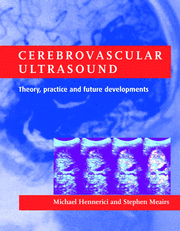Book contents
- Frontmatter
- Dedication
- Contents
- List of contributors
- Preface
- PART I ULTRASOUND PHYSICS, TECHNOLOGY AND HEMODYNAMICS
- PART II CLINICAL CEREBROVASCULAR ULTRASOUND
- (i) Atherosclerosis: pathogenesis, early assessment and follow-up with ultrasound
- (ii) Extracranial cerebrovascular applications
- (iii) Intracranial cerebrovascular applications
- 18 Transcranial Doppler ultrasonography and vasospasm after subarachnoid hemorrhage
- 19 Intracranial cerebral artery stenosis and occlusion
- 20 Arteriovenous malformations
- 21 High intensity transient signals
- 22 Transcranial Doppler monitoring during carotid endarterectomy
- 23 Cerebral vasoreactivity
- 24 Intracranial venous diseases: the role of ultrasound
- PART III NEW AND FUTURE DEVELOPMENTS
- Index
23 - Cerebral vasoreactivity
from (iii) - Intracranial cerebrovascular applications
Published online by Cambridge University Press: 05 July 2014
- Frontmatter
- Dedication
- Contents
- List of contributors
- Preface
- PART I ULTRASOUND PHYSICS, TECHNOLOGY AND HEMODYNAMICS
- PART II CLINICAL CEREBROVASCULAR ULTRASOUND
- (i) Atherosclerosis: pathogenesis, early assessment and follow-up with ultrasound
- (ii) Extracranial cerebrovascular applications
- (iii) Intracranial cerebrovascular applications
- 18 Transcranial Doppler ultrasonography and vasospasm after subarachnoid hemorrhage
- 19 Intracranial cerebral artery stenosis and occlusion
- 20 Arteriovenous malformations
- 21 High intensity transient signals
- 22 Transcranial Doppler monitoring during carotid endarterectomy
- 23 Cerebral vasoreactivity
- 24 Intracranial venous diseases: the role of ultrasound
- PART III NEW AND FUTURE DEVELOPMENTS
- Index
Summary
Introduction
Transcranial Doppler (TCD) is a useful tool for assessment of cerebrovascular reserve capacity in patients with high grade stenoses and occlusions of the internal carotid artery. Through measurement of cerebral vasoreactiviy, TCD may help identify patients with inadequate collateralization and increased risk of hemodynamic stroke who may benefit from surgical procedures. This chapter reviews the pathophysiologic basis of cerebral vasoreactivity and describes different techniques for its measurement with TCD. It provides an appraisal of the advantages and limitations of TCD methods as compared to other techniques for measurement of cerebrovascular reserve, and summarizes the implications of results on studies of cerebral vasoreactivity for treatment strategies in patients with carotid stenoses and occlusions.
Regulation of cerebral hemodynamics
The metabolic function of the human brain is protected by two hemodynamic mechanisms:
(i) Cerebral autoregulation enables constant cerebral blood flow (CBF) maintenance over a wide range of systemic blood pressure by varying the diameter of the intracerebral arterioles (Harper & Glass, 1965). This mechanism is also used to compensate for insufficiently collateralized internal carotid artery (ICA) stenoses and occlusions by lowering the peripheral vascular resistance. Maximal dilatation of the intracerebral arterioles, however, leads to decreased cerebral perfusion pressure and a corresponding reduction in CBF (Fig. 23.1).
[…]
- Type
- Chapter
- Information
- Cerebrovascular UltrasoundTheory, Practice and Future Developments, pp. 324 - 334Publisher: Cambridge University PressPrint publication year: 2001
- 3
- Cited by



